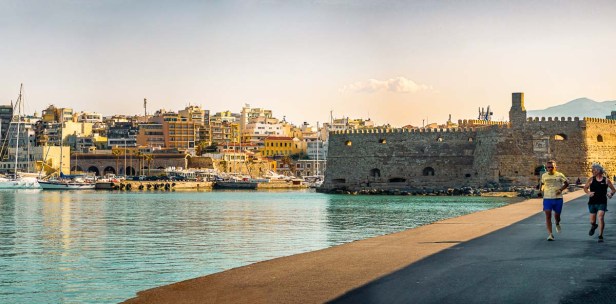
Even the goats won’t touch it. It presents a beautiful face to the world, especially in the spring, but it is so toxic that someone died from stirring their tea with a twig from it. Others have been poisoned from accidentally inhaling the smoke from burning branches. The powdered wood is used as rat poison. Oleander is not a plant you want to mess with. Apparently it has a lovely scent, but I decided I didn’t really need to get close enough to find out for myself. In Crete it is planted alongside the major roads as a deterrent to wandering goats. It works. We don’t see any goats.
And what a gift! We were in Crete in the late spring of last year, and everywhere we travelled on the island, from Chania to Elafonisi, to Kissamos, to Rethymno, and finally to Heraklion, we see blooming oleander bushes along the way, welcoming us with their luxurious pink and white flowers.
I first noticed the gorse bushes in Croatia any time we travelled throughout the countryside; in Crete they seem even more abundant. Gorse is everywhere, and in full bloom, a bright yellow companion to the oleander. Apparently gorse is tough enough to withstand the oleander’s toxic fortress.
And so on a bright day in early June we travel the 140 kilometres by bus from Chania to Heraklion, once known as Candia, and for nearly five hundred years the capital of this outpost of the Republic of Venice. It is now the capital, and largest urban centre of Crete, and pronounced, and often spelled, Iraklio. Or Iraklion.
I really want to see the Palace of Knossos so we’ve come to Heraklion because Knossos is nearby. Apart from that we have a couple of days in town with no real agenda so as usual we coddiwomple around to see what we can see. We’re staying in a centrally located Airbnb and walk for miles every day. At the top of the list, and the most obvious thing to see, is the Venetian port and castle.
Unlike Chania and Rethymno there’s not much left from the Byzantine era, or of the city the Venetians built, due an earthquake in 1926, and damage during WWII. But there is still the iconic artificial harbour built by the Venetians, and we’re drawn to it day after day.
A long breakwater with a fortress at the end, and a smaller sea wall opposite, curl around and protect a small sheltered bay that in the days of the Republic of Venice was one of the most important trading centres in the Mediterranean and a necessary stop en route to the East.
In the image below you can see the breakwater that connects the town to the fortress. In a huge engineering project the breakwater was created by sinking old ships filled with stone.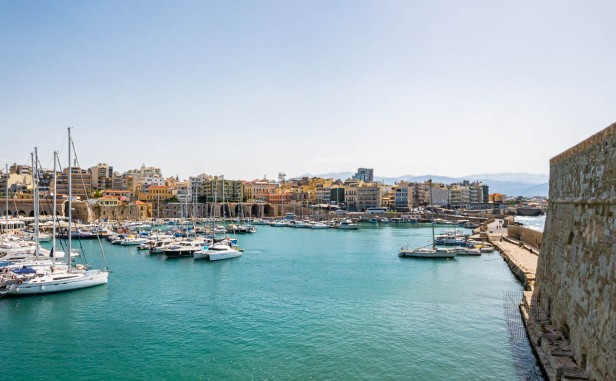
The castle is known simply as Koules, koules being the Turkish word for fortress. It was completed in its present form in 1540.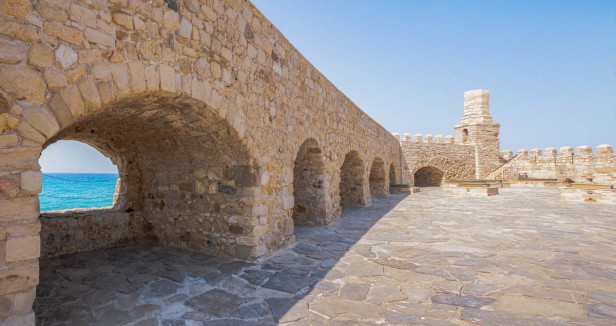


I notice a long low tunnel, off the ramp leading down to the interior, that’s overflowing with cannonballs. I’ve never seen so many. It’s quite the stockpile. I also notice the exquisite views back towards the city. Nice place for sentry duty.
Beyond the fortress there’s a modern breakwater 2.5 kilometres long. We walk almost to the end and discover the murals.

I can’t find any information about them. The images include the Abduction of Europa, Phoenician warships, Neptune, and many varied underwater scenes, a woman whose hair is octopus arms, several mermaids and flying dolphins, a man whose helmet is the head of a lion, a rendition of an ancient mural found on Santorini of a flotilla exploring the Mediterranean in the 1600’s BCE, and much more. It’s one long fascinating wall of street art.
The return journey, nearing sunset, gives us one of the best views of Koules, the symbol of the city.
We don’t really push ourselves in Heraklion – apart from a very early morning start to get to Knossos we have an easy couple of days wandering, then back to our small simple apartment for a rest, a little more flaneuring, then another rest, then looking for a place for dinner. And so it goes.
Out for breakfast one morning Don orders the “full English” and gets the biggest plate of food he’s ever seen: two fried eggs, several slices of bacon, sliced sausage, a pile of chips, a few baby tomatoes, and a mound of toasted bread fingers, and tea. Ali helps me by eating one of the eggs, one rasher of bacon, all of the tomatoes, some of the sausage, and some of the chips. After a rest at the cafe we wander back through the market and then back to the apartment for another rest . . . . . . . we find enough energy to go back to our new favourite ice cream store for another two scoops each – dark chocolate & orange, and passion fruit for me, mango and something else for Ali.
In our wanderings we find a Venetian church and the grand Morosini Fountain, both echoes of the past, some contemporary street art,
the small fishing fleet,

the Venetian Loggia, originally built as a club for the aristocracy and that’s now the town hall for the people,
some streets that take you back in time,
another with a whole row of bright flower pots,
and a restaurant with the best decor ever, elegantly showcasing contemporary Heraklion. It’s called The Home, Ethnic Bistro Bar. I don’t remember the food, other than that we enjoyed it, but I sure remember the inviting colourful ambiance.
The fortress is intriguing (especially the piles of cannon balls, which I’d never seen before), and has great views in all directions, the Venetian harbour is beautiful, and the long wall of street art on the modern breakwater a surprising and engaging discovery, but still, in the end, it’s the people I’m most drawn to photograph.

Maybe it’s because we’re not there in the high season, or maybe Heraklion’s not that big of a draw for tourists,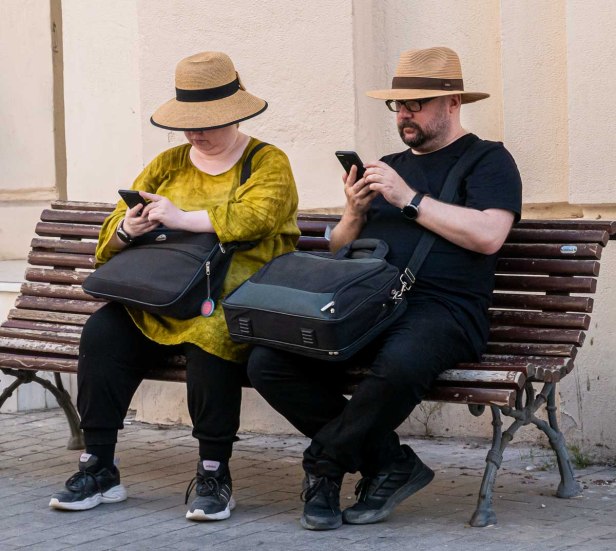


but we find there are very few, and everywhere we wander there are groups of locals,
the people of the city going about their daily lives,
hanging out at bars and cafe’s,


at restaurants at the end of the work day,
and shopping along the central market street.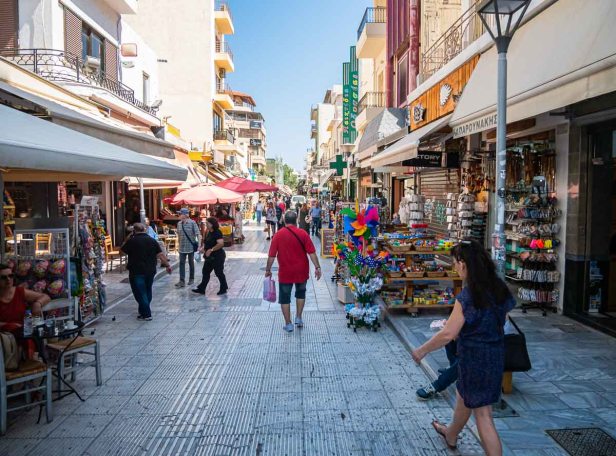




One day we sit in a cafe and watch as a man ducks in for a quick coffee, and his kid watches happily from the truck window.
And these men on the market street: I watch two old friends who delight in each other and who obviously haven’t seen each other for a while. They unexpectedly run into each other on the street: a huge joyous loving hug, words I don’t understand but the meaning is plain, and then a happy conversation.
Waiting,
chatting,
eating.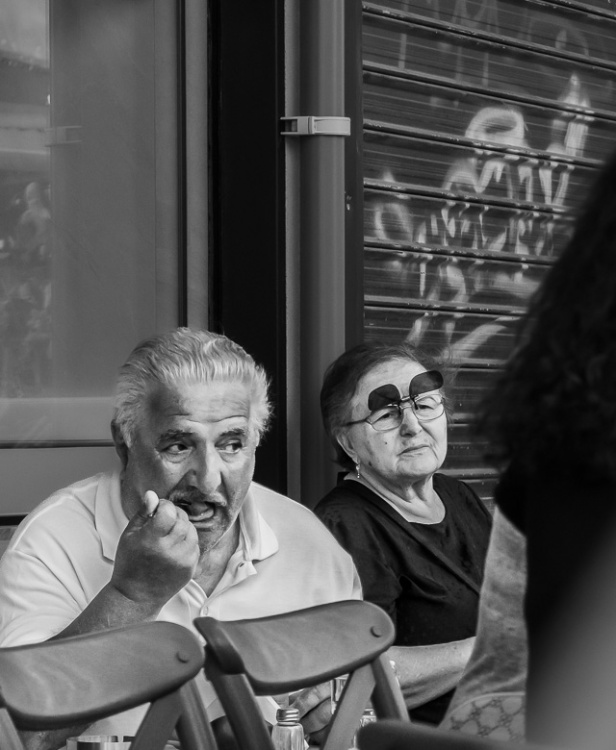

Collectively all these images are like a snapshot of Heraklion: a relaxed and vibrant city with a thriving cafe and restaurant scene; large central spaces cleared of traffic; a small working town that’s contemporary while honouring the past. The murals alone attest to Crete’s long and varied history, and Heraklion’s place in it. The city feels prosperous. And comfortable. We enjoy our brief stay there.
Next post: the Minoan Palace of Knossos – a huge bucket list item for me that didn’t disappoint. Magic!
All words and images by Alison Louise Armstrong unless otherwise noted
© Alison Louise Armstrong and Adventures in Wonderland – a pilgrimage of the heart, 2010-2023.

Great post. I love the Greek Islands. The topography is so similar to The Holler, including the oleanders!
LikeLike
Thanks so much Cindy. I too love the Greek Islands; now I get a feel for what the Holler is like. I hope I get back to Greece one day.
Alison
LikeLike
Great post & images
LikeLiked by 1 person
Thanks so much Indra.
Alison
LikeLike
So many wonderful Greek faces! We stayed at Rethymnon and visited Knossos from there. Sadly I don’t think we went into Heraklion.
LikeLiked by 1 person
I had such a good time photographing the people there. Although we enjoyed Heraklion, you certainly saw the best with Rethymnon and Knossos. (Though Chania is pretty special too).
Alison
LikeLiked by 1 person
What a wonderful tour. I haven’t been to Greece since 1977. Long overdue.
LikeLiked by 1 person
Thanks Peggy, glad you enjoyed it. I’d love to get back to Greece. The list of countries we’d like to return to is very short, but Greece is on the list. We just loved it, though I bet it’s changed a little from 1977!
Alison
LikeLiked by 1 person
Oleanders were used in dividers between freeway lanes in California for years. Seems I remember they were removed at some point but I could be wrong. Great tour, Alison. The Minor Palace has been on my wish list forever. I’m looking forward to your tour of it.
LikeLiked by 1 person
Thanks Curt. It seems an overview of Heraklion was the best way to go since we enjoyed it, and of course I had a million photos I wanted to share, but we were really there for Knossos; I’m glad you enjoyed this little tour.
I’d heard of oleanders, but that’s about it. I didn’t know what they look like, and I sure didn’t know how toxic they are. Maybe they’re no longer in Cali because they are so toxic and there’s no goat problem there 😂
Alison
LikeLike
No serious goat problem. Grin. They have learned however that goats are great for reducing vegetation in high fire areas. Their worst habits have become a plus. 🙂
LikeLiked by 1 person
Gorgeous street art! I did not know that about oleander; worth remembering (my partner wants goats someday, and keeping them out of things will be handy!)
LikeLiked by 1 person
The street art along that breakwater was an amazing find! And if you look online there’s nothing about it – that I could find anyway. I think there’s stuff about the breakwater, and about walking out to the lighthouse, but no mention about the murals which must have been some huge group effort.
Oleanders would be the perfect solution to any future goat problem – just be sure to always wash anything that touches them 😁
Alison
LikeLike
Great story and pictures again, they tickle my senses.
I love the word coddiwomple! My very extensive dictionary didn’t have it.
LikeLiked by 1 person
Thanks so much Astrid. Glad I managed to tickle your senses 😁 (I love this way of putting it).
I think your dictionary may be a bit conventional and old fashioned 🤪
Alison xo
LikeLike
Everything exudes warmth – the stone, the sun, the faces. Makes me fall in love with Greece all over again. The harbor really reminded me of Malta, perhaps because that’s the last Mediterranean place I’ve been! I need more TIME … I keep thinking I have seen much of what I hope to see in this world, but then I am reminded by posts like this that there are a gazillion places I want to go back to, let alone anywhere new!
LikeLiked by 1 person
Yes, a thousand times yes to your last sentence. And I keep choosing new countries even though I fell in love with Greece and hardly scratched the surface and would love to go back. So much world, so little time. Sigh.
As for Heraklion – it *did* exude warmth, not just the temperature, but also the way people were so relaxed, and the sun shining on the luminous blue water, and I’m sure that’s all part of why we loved it.
Alison
LikeLiked by 1 person
It’s crazy to think that something so pretty can be so deadly! The breakwater and the koules really make Heraklion even more charming. And that shot of the fortress at sunset is really beautiful! From your photos, this city looks like a really nice place to explore in a leisurely pace, with not-so-many tourists around, and interesting restaurants to try. I’m eagerly looking forward to your post on the Palace of Knossos! Ever since I watched the opening ceremony of the Athens Olympics, where parts of the program were directly inspired by the murals from the palace, I’ve wanted to see this ancient site in person.
LikeLiked by 1 person
Thanks so much Bama. Heraklion’s a lovely, charming, and laid back city, and yes, the Venetian breakwater and fortress make it quite special. We were there late spring and it was quiet, but for sure I can’t vouch for July/August – at may be really crowded in the high season. Apart from Knossos there are other places to explore fairly nearby (beaches etc) that could also make it more crowded in the summer.
Isn’t the oleander amazing! I had no idea!
Running off now to watch the opening ceremony of the Athens Olympics! I’ve never seen it but I’d love to see the part inspired by the Minoans.
Alison
LikeLiked by 1 person
The thing about that opening ceremony is there are two versions of it: the NBC version (for U.S. audience) and the international version, each shot with different sets of cameras placed at different angles. The thing about the U.S. version is that there are parts that were intentionally shot using a camera placed faraway in the stadium as opposed to close up shots for international audience because of censorship rules in the U.S. Case in place: the opening of the “Clepsydra” section which shows a topless Minoan snake goddess. This is a clip of the international version for you to enjoy (it shows fragments of Greek history from antiquity to modern time): https://www.youtube.com/watch?v=bh91qDz4xQU
LikeLiked by 1 person
Thanks Bama. This is the same link I found. Loved it. I guess being in Canada I qualify for the international audience. US censorship laws are so weird.
Alison
LikeLiked by 1 person
This was just the thing to see after a cool, rainy day…
LikeLiked by 1 person
Thanks Dave, glad you liked it.
Alison
LikeLiked by 1 person
Oleander, I’ve always wondered about it… it is beautiful. Heraklion, its iconic artificial harbor, and the fortress/Koules are so cool ~ I enjoy visiting places like this as it gets the imagination going on what it could have been like back in history. To have this feeling with Koules and then the Venetian Loggia, what a way to escape into a vacation 🙂 The pieces of history still linger with the small streets, and your photography shows how well it all blends in with the modern times. Your excitement about exploring is so evident in this and all your posts.
LikeLiked by 1 person
Thanks Dalo. I haven’t seen enough of Europe, not much at all really, so when I’m there I’m always as much drawn to the historical aspects of exploring as the physical, and the juxtaposition of ancient and contemporary. There’s more evidence of the Venetian history in Chania and Rethymno, but still, Heraklion drew me in for sure. And Knossos (next post) a whole lot more.
Learning about oleander was a great surprise – what a plant! Nature’s always so amazing.
Alison
LikeLike
Great people images! We stayed near the waterfront (where the fortress is) but didn’t have enough time to explore the city. One of those many, many stop trips during a finite vacation time my son had. Sorry to have missed the murals, they would have drawn me in.
LikeLiked by 1 person
Thanks so much Ruth. Photographing the people is my favourite thing. Endlessly entertaining.
I know those trips where too much is packed in, and you only get a brief glimpse. Even our trip, having a few days in each place, felt too rushed.
Alison
LikeLike